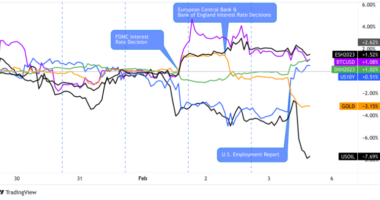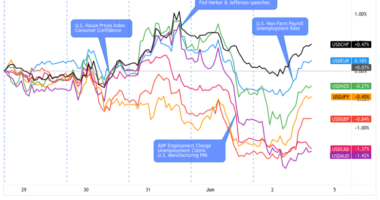One of the most versatile indicators used by technical analysts and chart readers is the moving average. There is a variety of moving averages to choose from such as the simple, exponential, or hull moving average and most other indicators include a moving average in their calculation.
The moving average can be applied to any chart time frame from monthly down to 1-minute charts. As a result, the moving average indicator is arguably the most popular indicator used by forex and crypto traders.
Over the next few minutes, we will review what the moving average is, how to read it, and some strategies a forex or crypto trader can use with it.
How to Read the Moving Average Indicator
The moving average is a formula used to calculate the average of a market’s movements over a period of time to identify the direction of the trend and potential buy/sell zones.
There are several types of moving averages and the two most popular are the simple and exponential moving averages.
Fortunately, you don’t have to make the calculations as the charting software will do that for you.
However, the main difference between the simple and exponential is how responsive the moving average is to the current price.
For example, a simple moving average is a simple average of the prices for a certain period of time. However, the simple moving average can be slow to respond to quick changes in the market. Therefore, the exponential moving average was developed to respond quickly to abrupt price movements by weighting the recent prices more heavily.
Each type of moving average will include a “look back” input period. This alerts the formula for how many data points to incorporate into the calculation. Two common input periods are 50 and 200, but any whole number can be used in the calculation.
Once the trader has decided the type of moving average and the look back input for the moving average, a line will be displayed on the price chart. This line can identify several useful items.
For example, the direction the line is pointing will indicate the direction of the trend. If the line is pointed higher, then the trend is said to be up and vice versa for a downward sloping moving average.
Additionally, the current price level of the line can act as support and resistance indicating price levels to buy or sell.
Importance of MA Indicator in Forex & Cryptocurrency
Due to the flexibility and versatility of the moving average, it is one of the most popular indicators used by forex and cryptocurrency traders. Aside from the flexibility of customizing your own look back input period and the versatility of using it on any chart time frame, the moving average helps you determine the direction of the trend and hence, the side of the trade to be on.
Additionally, the moving average can identify price levels such as when prices are oversold and overbought which can help predict rallies and corrections.
Trading crypto with the moving average is quite simple.
- Log into your account with a top crypto exchange such as Bybit. Pull up a price chart of the digital asset you are wanting to trade within the daily time frame.
- Apply a 20, 50, 100, or 200-period simple moving average to your chart.
- When the moving average is pointed higher, it can be a signal to buy and vice versa.
Using MA Indicator with Other Trading Strategies
The moving average indicator is extremely useful and can be used as a stand-alone strategy. However, the crypto market is notorious for wild and volatile price swings which can wreck the nerves of traders and their account balance. Therefore, when learning to trade crypto, traders will apply other indicators to help make the trends and signals clearer.
If you are new and want to learn crypto trading, consider these strategies to help you get started.
The Moving Average Crossover Strategy
If one moving average is good, then two should be better. The single-moving average on the price chart is susceptible to frequent false signals in a sideways market. At times, crypto will make a large price move only to retrace that trend shortly thereafter.
These volatile moves can place traders using a single moving average in a bad position.
As a result, adding two moving averages to the price chart of different lengths will allow the trader to assess the direction of the trend without whipsaws. For example, add the 50 and 200-period moving average on the chart. When the 50 line crosses above the 200 line, then the trend is said to be up and traders will want to buy. When the 50 line crosses below the 200 line, the trend is said to be down and traders will want to sell.
The ADX Moving Average Strategy
Moving averages provide excellent signals in trending markets. The nemesis to a moving average are sideways ranges. One way to filter out sideways ranges is using an indicator called the Average Directional Indicator (ADX).
Apply the ADX to your chart and when it moves above a reading of 20, then the market is trending and the moving averages will provide better signals. If the ADX is below 20, then a sideways range has developed and traders might want to ignore any moving average signals you receive.
Moving Average Convergence Divergence Strategy
The Moving Average Convergence Divergence oscillator (MACD) is a popular indicator that uses moving averages. This indicator combines several components into an easy-to-read signal generator.
It is another indicator that you can add to your price chart that appears in a window at the bottom of the chart. There are two lines on it that can be traded in a similar fashion to the Moving Average Crossover Strategy above.
When the leading line crosses above the lagging line, that is a bullish signal to buy. When the leading line crosses below the lagging line, that is a bearish signal to sell.
Conclusion/Takeaway/Final Words
Among forex and crypto traders, the moving average is one of the most popular indicators.
Traders looking to transition from forex and learning to trade crypto will typically utilize moving averages of some form within their strategy.














